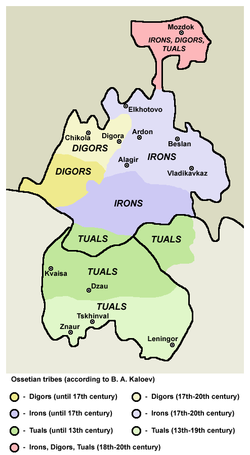Digor people
Дигорӕ, Дигорӕнттӕ | |
|---|---|
Ossetian flag | |
| Total population | |
| ~100,000 | |
| Regions with significant populations | |
| est. 100,000 | |
Digor) | |
| Religion | |
| Majority: Minority: | |
| Related ethnic groups | |
| other Iranian peoples | |
| |

The Digor or Digor people (
2010 Russian Census their number was only 223.[8] It was estimated that there are 100,000 speakers of the dialect,[9] most of whom declared themselves Ossetians. The Digor mainly live in Digorsky, Irafsky, Mozdoksky districts and Vladikavkaz, North Ossetia–Alania, also in Kabardino-Balkaria, Turkey and Syria
.
Etymology
Scholars generally link the root dig- with the Circassian
endonym A-dyg-e, where the suffix -or could be a mark of plurality as found in many contemporary Caucasian languages.[10][11]
This point of view was criticized by R. Bielmeier and D. Bekoev, they raised the ethnonym to "tygwyr" in the Iron dialect, meaning "gathering, gathering, group."
History
Middle Ages
The early medieval Mongol conquests.[citation needed]
Genocide of 1944
During
Collaboration with the Germans and deported to Central Asia. Estimates say 50% of the Digors died during deportation. Their reputation was rehabilitated in the mid-1950s, and they were allowed to return to their homelands.[12][13]
Religion
Islam
The Digors were converted to
emigrated to the Ottoman Empire.[citation needed
]
Demographics
Digors make the majority of the Ossetians in Digoria, the western part of the North Ossetia–Alania (Digorsky and Irafsky districts), and in Kabardino-Balkaria. In the beginning of the 19th century some families from Digoria resettled in Mozdoksky District, where they reside in the settlements of Novo-Osetinskaya and Chernoyarskaya.[14]
See also
- Ossetians
- Ossetian Muslims
- North Ossetia–Alania
- Digor (dialect)
- Jassic (dialect)
Sources
- Wixman. The Peoples of the USSR, p. 58
References
- ^ "First Ethnic Ossetian Refugees from Syria Arrive in North Ossetia". Jamestown. Retrieved 2022-10-16.
- ^ ISBN 978-1-57958-133-6.
- ^ "Ossetian Digorians. The mystery of the origin of iriston, digoras and the great tamerlane".
- ^ "Archived copy". Archived from the original on 2017-02-05. Retrieved 2017-02-04.
{{cite web}}: CS1 maint: archived copy as title (link) - ^ http://s50.radikal.ru/i129/1003/22/2fec9d793e3d.jpg [bare URL image file]
- ^ Камболов, Тамерлан Таймуразович (2006). Очерк истории осетинского языка. Владикавказ: Ир. p. 410.(in Russian)
- ^ "Russian Census 2002: Population by ethnicity" (in Russian). Archived from the original on 29 February 2016. Retrieved 19 April 2014.
- ^ "Russian Census 2010: Population by ethnicity" (PDF) (in Russian). Retrieved 19 April 2014.
- ^ "Digor in Russia". Joshua Project. Retrieved 17 May 2014.
- ^ a b Абаев, Василий И. (1958). Историко-этимологический словарь осетинского языка. Том I (А-К) (in Russian). Москва - Ленинград: Издательство Академии наук СССР. pp. 379–380.
- ^ ISBN 978-90-04-11442-5.
- ^ ISBN 0-313-27497-5.
- ISBN 0-313-32111-6.
- ^ "Ossetian Digorians. The mystery of the origin of iriston, digoras and the great tamerlane".

